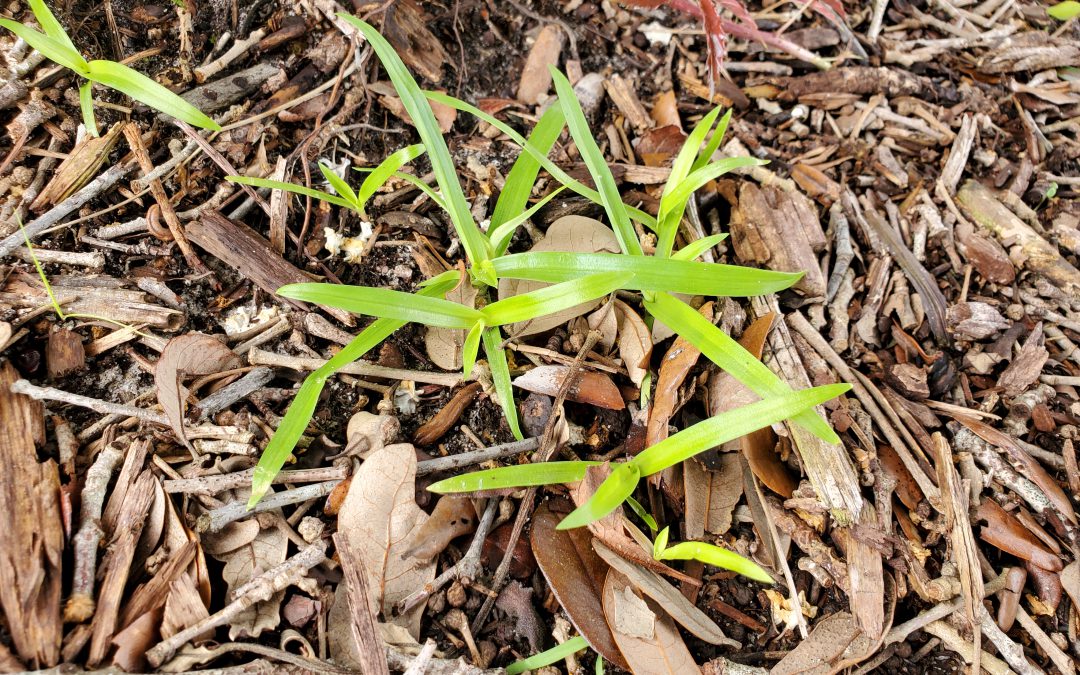
by Daniel J. Leonard | May 12, 2022
It’s the most asked question of Extension agents everywhere. “What is this weed and what herbicide should I buy to kill it?” The first part of that question is straightforward. Between personal field experience, formal plant identification training, and a team of weed science specialists to call on, Florida Extension Agents can get your weed accurately identified. The second part of the question is slightly more nuanced. Many weed problems can be avoided by following lawn and landscape Integrated Pest Management (IPM) practices, like not overwatering, mowing at the correct height, using mulch where you can, etc., but sometimes herbicides are required. For these situations, if you follow the “homeowners only need four post-emergent herbicides rule”, you’ll be ready for any weed challenge you face!*
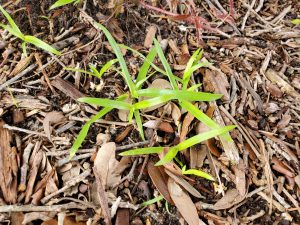
Doveweed seedlings just emerged on July 9, 2021. Photo courtesy of Daniel Leonard.
The first weed scenario you should be prepared for is spot spraying weeds in landscape beds and around hardscapes like concrete pads, sidewalks, pools, driveways, etc. For this situation, you’ll turn to the backbone of the four herbicides rule and a staple in any weed management program, glyphosate. Glyphosate is the active ingredient (AI) in many non-selective products ranging from the infamous Roundup brand to cheaper generics like Killzall and Cornerstone. Glyphostate is extremely cost-efficient and very effective on a huge range of emerged weeds including grassy weeds, broadleaf weeds, and even sedges (also called nutsedge or “nutgrass”). Just be sure not to get any overspray on desirable plants or they’ll be seriously damaged!
The second situation we face occurs when “bad” grassy weeds invade landscape beds, shrubs, and vegetable gardens. These cases call for a grass-selective herbicide that you can spray right over the top of your broadleaf annuals, perennials, and shrubs to take out the unwanted grasses. In this case, there are two options at your disposal: sethoxydim (AI in many products like Fertilome Over the Top, Hi-Yield Grass Killer, Poast, etc.) and fluazifop (AI in the product Fusilade). Both products work well in removing weeds like crabgrass, bermudagrass, goosegrass, and others and can be safely applied over the top of many ornamentals.
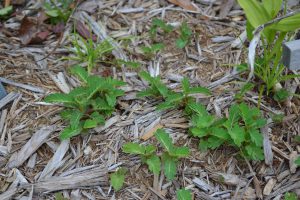
Seeds from annuals like Chamberbitter easily get into mulch and turfgrass from surrounding areas. Photo by Beth Bolles, UF Extension Escambia County
From time to time, we need to treat a broadleaf weed like dollarweed, doveweed, chamberbitter, or any number of others, that have invaded our lawn grass. Some of these weeds are tougher than others, but almost all of them can be managed with the proper rates of 2,4-D, Dicamba, other similar products, or a combination of several of them. These active ingredients have been on the market for decades so there are many generic options at your disposal. However, if you have a truly tough broadleaf weed problem, the newer product Celsius WG from Bayer (a combo of Dicamba and two newer AIs), while a little pricey and only available online or at specialty chemical dealers, is well worth the expense and knocks out the most gnarly of lawn weeds.
Finally, there is a category of weeds that aren’t broadleaves and aren’t quite grasses either. These are the sedges. Commonly known around the Panhandle as “nutgrass”, sedges are a serious pest of lawns, particularly those that stay a little on the damp side, and vegetable gardens. Sedges, with their glossy leaves and distinctive flowers, stand out in lawns and gardens, are very unsightly in an otherwise well-maintained area, and can outcompete the desirable plants they invade. Fortunately, there are several AIs that work very well on sedges and are safe to use around turfgrass and many other plants. The most effective sedge herbicide AI for homeowners is halosulfuron-methyl (AI in Sedgehammer in lawns and Sandea and Profine in vegetables). Sedgehammer works very slowly (results can take up to a month) but is very safe in turfgrass and ornamentals and highly effective! If Sedgehammer and other halosulfuron products are difficult to obtain, Imazaquin is a slightly less effective but more common substitute. This AI can be found in the product Image Kills Nutsedge and is safe for use in turfgrass and most ornamental plantings.
The challenge of controlling the many types of weeds in your lawn, landscape, and vegetable garden seems daunting, but having just four basic classes of herbicides on hand can greatly simplify things! Whether you need to control a broadleaf, grass, or sedge weed problem, putting together a weed control toolbox containing a non-selective herbicide like glyphosate, a broadleaf selective like 2-4,D, a grass selective like sethoxydim, and a sedge selective like halosulfuron-methyl can allow you to handle most any weed you come across at home. For more information on controlling weeds in home landscapes and gardens or any other horticultural topic, contact your local UF/IFAS Extension office. Happy gardening!
*Most homeowners discover weed problems after the weeds are already up and growing, making post-emergent products necessary. Pre-emergent products have a place in weed management programs but are not the focus of this article.
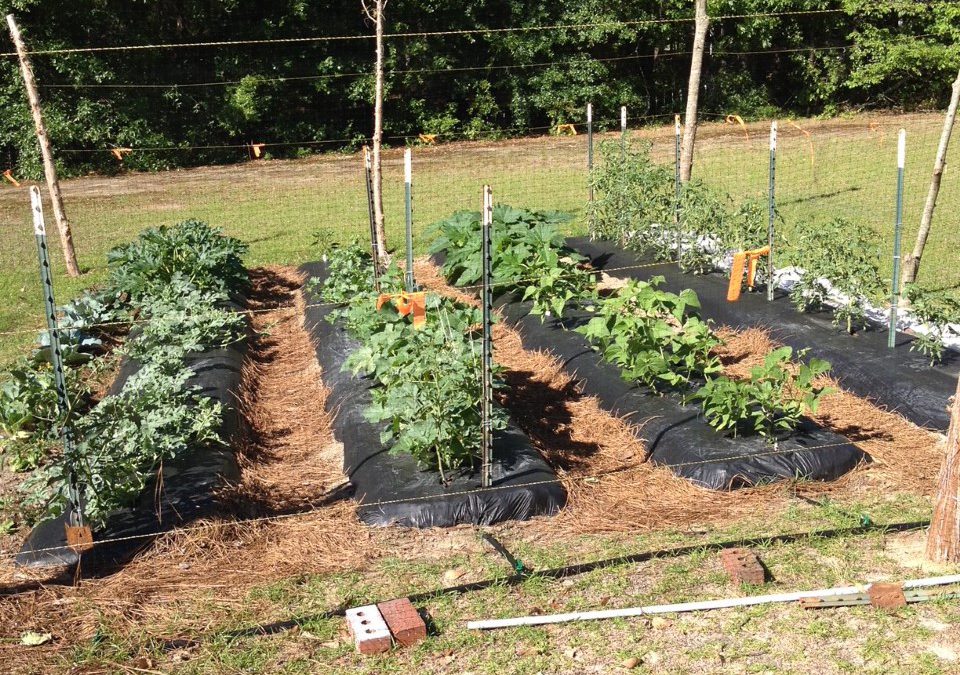
by Stephen Greer | Apr 14, 2022
We all must begin somewhere in horticulture, including growing yummy vegetables of your own to enjoy and share. This activity, or is it passion, has a long colorful history while most of the time provides an exceptional food source. It can be a bit daunting the first time you try and maybe even the others to follow with determining what, when, where and how to plant for a future harvest.
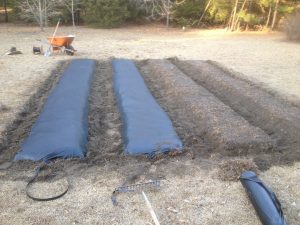
Raised Bed Vegetable Garden with Drip and Black Plastic. Photo Credit: Stephen Greer, UF/IFAS Extension – Santa Rosa
Selecting that convenient site in full sun easy with access to check on the plants progress. Things you will need to consider are the number of hours of direct sun the garden area will receive. Most garden vegetables will need at least eight hours of sunlight. Many of the leafy greens can be grown with less than eight hours with the least amount of sun at six hours. All others will need eight or more hours of sunlight. Water is a critically important part of successful vegetable garden. Too little water and the plants will not survive well and produce little and too much will reduce or end plant production. A general rule is one inch of water a week during the growing season. This can come from rain or irrigation and likely is a combination.
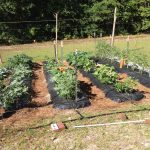
Mid-Spring Production with Managed Irrigation. Photo Credit: Stephen Greer – UF/IFAS Extension – Santa Rosa
Planning your garden before doing anything else is critically important. Take out a paper and pencil and sketch out how you want to plant your garden and what you want to grow. Start by drawing rows and labeling each row. Think about spacings between plants in the rows and between rows. Do you plan to plant everything in the ground, raised beds or on a trellis? More effective space utilization can occur by planting two- or three-foot-wide beds to plant multiple narrow rows that can be managed and harvested from both sides of the bed. Some plants to think about growing this way are leafy greens such as lettuce, kale, onion and others.
Going vertical to grow vine type plants like beans, cucumbers, early spring peas and others can be a fun part of gardening. This type of gardening allows for more space use over the same ground area. Other plants can be grown in the same bed depending on the light.
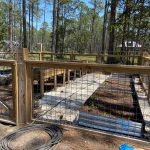
Multiple Types of Raised Beds. Photo Credit: Stephen Greer, UF/IFAS Extension – Santa Rosa
If you have interest in growing with raised beds, there are a number of materials that are used to build the beds. First do not use old railroad ties as they will leach chemicals into the soil that the vegetables can possibly take up or contaminate your soil. I have seen all kinds of creative materials used including cedar wood, plastic boards or preformed beds, even old whiskey barrels with legs built under. Do not forget all kinds of planting containers are available in the marketplace. Make sure there are drain holes in the bottom to allow the water to properly move through.
This is just the beginning of vegetable gardening. Other things to plan involve when to plant, what to plant, what is the budget, use seeds or transplants, depth of planting, watching for plant pests, harvest, storage and so on. Enjoy your gardening adventure!
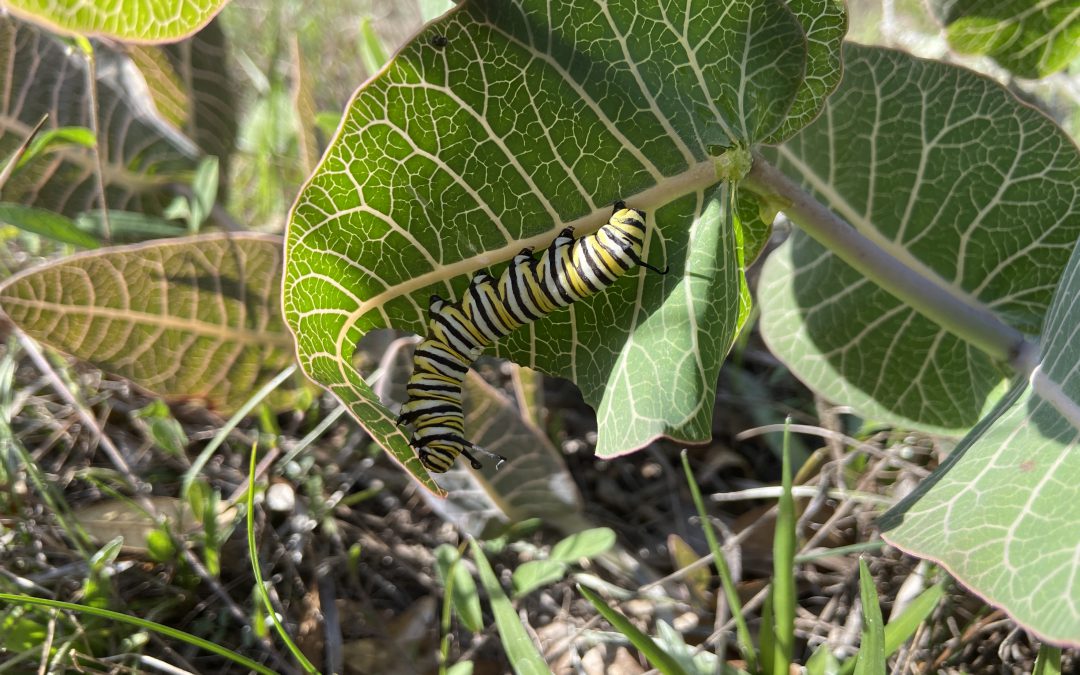
by Mary Salinas | Aug 20, 2021
On August 12, 2021, our panel answered questions on a wide variety of landscape topics. Maybe you are asking the same questions, so read on!
Ideas on choosing plants
What are some perennials that can be planted this late in the summer but will still bloom through the cooler months into fall?
Duranta erecta ‘Sapphire Showers’ or ‘Gold Mound’, firespike, Senna bicapsularis, shrimp plant, lion’s ear
Where can native plants be obtained?
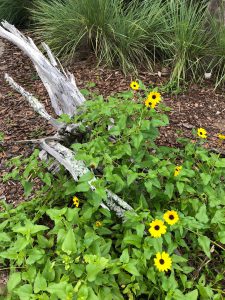
Dune sunflower, Helianthus debilis. Photo credit: Mary Salinas UF/IFAS Extension.
Gardening Solutions: Florida Native Plants – see link to FANN: https://gardeningsolutions.ifas.ufl.edu/plants/ornamentals/native-plants.html
What are some evergreen groundcover options for our area?
Mondo grass, Japanese plum yew, shore juniper, ajuga, ferns such as autumn fern.
What are some ideas for partial morning sun butterfly attracting tall flowers to plant now?
Milkweed, salt and pepper plant, swamp sunflower, dune sunflower, ironweed, porterweed, and salt bush.
I’m interested in moving away from a monoculture lawn. What are some suggestions for alternatives?
Perennial peanut, powderpuff mimosa, and frogfruit.
We are new to Florida and have questions about everything in our landscape.
Florida-Friendly-Landscaping TM Program and FFL Web Apps: https://ffl.ifas.ufl.edu/
https://ffl.ifas.ufl.edu/resources/apps/
UF IFAS Gardening Solutions: https://gardeningsolutions.ifas.ufl.edu/
What are some of the top trends in landscaping today?
Houseplants, edible gardens, native plants, food forests, attracting wildlife, container gardening, and zoysiagrass lawns
Edibles
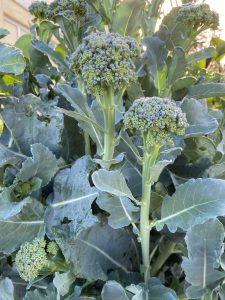
Artwork broccoli is a variety that produces small heads. Photo credit: Mary Salinas UF/IFAS Extension.
What vegetables are suitable for fall/winter gardening?
Cool Season Vegetables: https://gardeningsolutions.ifas.ufl.edu/plants/edibles/vegetables/cool-season-vegetables.html
North Florida Gardening Calendar: https://edis.ifas.ufl.edu/publication/EP451%20%20%20
Florida Vegetable Gardening Guide: https://edis.ifas.ufl.edu/publication/vh021
How can I add herbs to my landscape?
Herbs in the Florida Garden: https://gardeningsolutions.ifas.ufl.edu/plants/edibles/vegetables/herbs.html
My figs are green and hard. When do they ripen?
Why Won’t My Figs Ripen: https://www.lsuagcenter.com/profiles/rbogren/articles/page1597952870939
What is best soil for raised bed vegetable gardens?
Gardening in Raised Beds: https://edis.ifas.ufl.edu/publication/EP472
And there are always questions about weeds
How can I eradicate cogongrass?
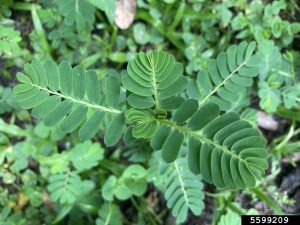
Chamber bitter is a troublesome warm season weed in our region. Photo credit: Brantlee Spakes Richter, University of Florida, Bugwood.org
Cogongrass: https://edis.ifas.ufl.edu/publication/WG202
Is it okay to use cardboard for weed control?
The Cardboard Controversy: https://gardenprofessors.com/the-cardboard-controversy/
What is the best way to control weeds in grass and landscape beds?
Weed Management Guide for Florida Lawns: https://edis.ifas.ufl.edu/publication/EP141
Improving Weed Control in Landscape Planting Beds: https://edis.ifas.ufl.edu/pdf/EP/EP52300.pdf
Landscape practices
Can ground water be brackish and stunt plants?
Reclaimed Water Use in the Landscape: https://edis.ifas.ufl.edu/publication/ss545
How can I prevent erosion from rainwater runoff?
Stormwater Runoff Control – NRCS: https://www.nrcs.usda.gov/wps/portal/nrcs/detail/national/water/?cid=nrcs144p2_027171
Rain Gardens: https://gardeningsolutions.ifas.ufl.edu/design/types-of-gardens/rain-gardens.html
And https://gardeningsolutions.ifas.ufl.edu/pdf/articles/rain-garden-manual-hillsborough.pdf
What is the best time of the year to propagate flowering trees in zone 8B?
Landscape Plant Propagation Information Page – UF/IFAS Env. Hort: https://hort.ifas.ufl.edu/database/lppi/
Which type of mulch works best on slopes greater than 3 percent?
Landscape Mulches: How Quickly do they Settle?: https://edis.ifas.ufl.edu/publication/FR052
When should bulbs be fertilized?
Bulbs and More – UI Extension: https://web.extension.illinois.edu/bulbs/planting.cfm
Should I cut the spent blooms of agapanthus?
Agapanthus, extending the bloom time: https://gardeningsolutions.ifas.ufl.edu/plants/ornamentals/agapanthus.html
http://blogs.ifas.ufl.edu/wakullaco/2020/10/07/extending-bloom-time/
Plant questions
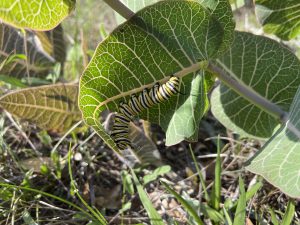
Monarch caterpillar munching on our native sandhill milkweed, Asclepias humistrata. Photo credit: Mary Salinas, UF IFAS Extension.
I planted native milkweed and have many monarch caterpillars. Should I protect them or leave them in nature?
It’s best to leave them in place. Featured Creatures: Monarch Butterfly: https://edis.ifas.ufl.edu/pdf/IN/IN780/IN780-Dxyup8sjiv.pdf
How does Vinca (periwinkle) do in direct sun? Will it make it through one of our panhandle summers? Can I plant in late August?
Periwinkles and No more fail with Cora series: https://gardeningsolutions.ifas.ufl.edu/plants/ornamentals/periwinkles.html#:~:text=Plant%20your%20periwinkles%20where%20they,rot%20if%20irrigated%20too%20frequently.
Insect and disease pests
What to do if you get termites in your raised bed?
The Facts About Termites and Mulch: https://edis.ifas.ufl.edu/publication/IN651
How to combat fungus?
Guidelines for ID and Management of Plant Disease Problems: https://edis.ifas.ufl.edu/publication/mg442
Are there preventative measures to prevent diseases when the humidity is very high and it is hot?
Fungi in Your Landscape by Maxine Hunter: http://blogs.ifas.ufl.edu/marionco/2020/01/16/fungi-in-your-landscape/
If you missed an episode, check out our playlist on YouTube https://www.youtube.com/watch?v=bp0HfdEkIQw&list=PLhgoAzWbtRXImdFE8Jdt0jsAOd-XldNCd
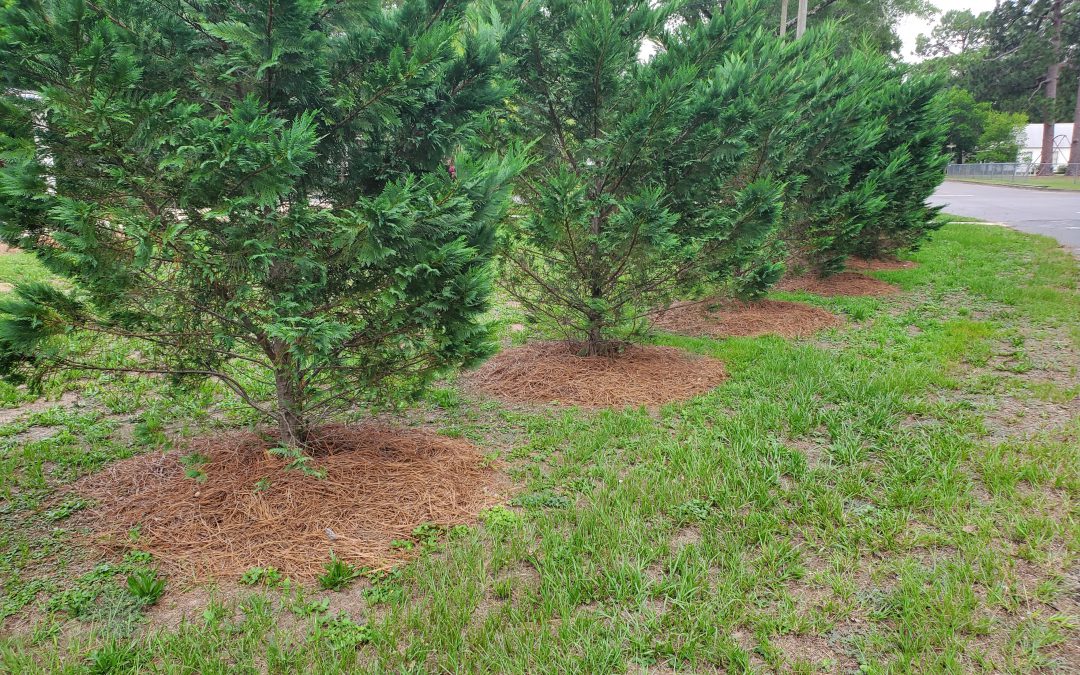
by Evan Anderson | Jul 1, 2020
A lot can go wrong in a garden or landscape, but proper preparation can help to avoid many of these problems from popping up in the first place. For some of these problems, a good preventative measure is mulch.
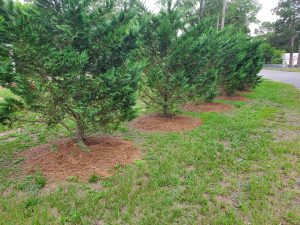
Pine straw is a common material used as mulch.
Mulch is any material that’s spread over the surface of the soil. One of the most common materials used in our area is pine straw, which is simply the needles of pine trees harvested from forested lands. Pine bark, another byproduct of the forestry industry, can be found easily as well. Both of these mulches will tend to have an acidifying effect on soils over time.
Other popular mulches include shredded or chipped wood. Melaleuca trees were originally planted in South Florida in an attempt to convert wetlands into farmable areas; to help remove this invasive species, the trees are now cut and ground into mulch. Eucalyptus mulch is also popular, as well as cypress, though it can be difficult to determine where cypress mulch originated from. Improperly harvested cypress can damage Florida’s natural wetlands. Hardwood mulch from other species may also be found.
Utility companies may sometimes give away mulch produced as they trim trees and bushes along their power lines, but this should be used only with the understanding that it may contain weed seeds or traces of herbicides or other chemicals. Homeowners may sometimes produce their own mulch in the form of raked leaves or grass clippings, but the same concerns about weed seeds and chemicals apply here as well.
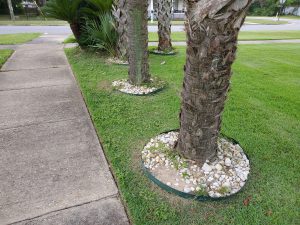
Mulch can be used to help avoid hitting plants with a mower or trimmer.
Gravel or pebbles may often be used, especially in wet areas, or close to houses where flammable materials may be ill advised. Lastly, garden mulches may include materials such as paper or plastic spread in sheets over the ground.
Choosing the proper mulch can depend on the reason for its use. There are a number of effects mulch can have on a garden or landscaping bed. Mulch can help to retain moisture in the soil, keep weed growth down, reduce erosion, and act as a temperature buffer for the soil and plant roots below. It may also add visual appeal and help to keep lawn mowers and trimmers from needing to get too close to plants which may be damaged by them.
Whatever the reasons for adding mulch, there are a few things to avoid. Do not mound mulch around the base of plants. Moisture held against the trunk or stem of a plant can lead to fungal problems. Try to maintain a layer two to four inches deep. Any less and weeds will grow through the material; more mulch will not allow water to filter properly to the ground. Finally, if mulch becomes clumped and matted over time, do not let these block air or moisture to areas below. Rake or stir the mulch to evenly spread it.
You can find more information on mulching at our EDIS site https://edis.ifas.ufl.edu/topic_mulch or in the Florida Friendly Landscaping site at https://ffl.ifas.ufl.edu/handbook/Mulch_vSept09.pdf.

by Larry Williams | Dec 4, 2019
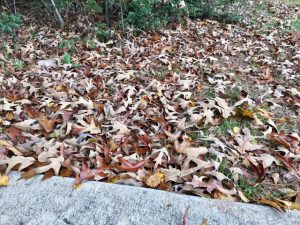
Fall oak tree leaves abound and can be recycled as landscape mulch. Photo credit: Larry Williams
Weed control is not top on my list as a reason to use mulch. There are weeds that can push through mulch such as nutsedge (nutgrass) or that can germinate and grow in the mulch. But done correctly, mulching plant beds and gardens can help inhibit some weeds. Tree leaves can be used as a mulch.
In addition to weed control, mulch provides other benefits. It can make landscapes look more attractive. It keeps roots evenly moist, acts to insulate roots from extreme heat and cold and can help decrease loss of soil from wind and water erosion. Mulch serves as a barrier to some soil-borne diseases, especially in the vegetable garden. And, as organic mulch breaks down, it improves the soil’s fertility, aeration, structure and drainage.
Tree leaves make good mulch. They can be placed on the soil surface beneath and around shrubs, trees, perennials, annuals and vegetables.
Fall leaves are abundant. Some people feel overwhelmed by the volume. One resident reported raking more than 100 large bags of leaves from his half-acre property. One large oak tree can contain over 250,000 leaves!
Tree leaves can be placed in landscape beds or around vegetables “as is” or chopped up with a shredder or mower into smaller pieces and then spread around vegetables, shrubs and trees. Mixing leaves from several different species of trees can make better leaf mulch. Leaves of the same size tend to mat together and produce a shingling effect that can shed water and reduce gas exchange in the soil. Shredded leaves stay seated better on the landscape than whole leaves.
A mulch layer three inches deep after settling is enough for most plants. If possible, extend the mulched areas out to the outermost leaves (called the drip line) and beyond. And be sure to pull the mulch back a few inches from the main trunk. Never pile mulch around the trunk.
Using those fallen tree leaves as mulch recycles a natural resource and saves you money, enriches your soil, fertilizes your plants and keeps them out of the local landfill.
So, instead of putting all those leaves curbside in plastic bags to be hauled off, use them to benefit your landscape, which may include less weeds.
For additional information on landscape/garden mulch, contact the UF/IFAS Extension Office in your County or access the following sites.
http://gardeningsolutions.ifas.ufl.edu/care/planting/mulch.html
http://edis.ifas.ufl.edu/topic_mulch

















